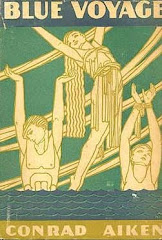
S.S.
Ile de France was the ship that Malc's first wife Jan Gabrial sailed back to America on in 1934 and features in Malc's short story 'In Le Havre'.
I was recently exchanging mails with my fellow Lowryan scholar Annick Drösdal- Levillain which included the topic of coincidence. Annick wrote:
I recently salvaged a framed photograph of a ship my mother was about to throw away in her cleaning up frenzy. Now this photograph was taken by a fellow swimmer of my grandfather's and it happens to be the L'île de France, in Le Havre, in 1950. I kept it, thinking that it looked like the ships Lowry must have sailed, that was all. And now I fell upon it in your postcards... I was then puzzled to see that on your picture the ship has three funnels whereas on mine it has two. Wikipedia came to the rescue (the ship was launched in June 1927...modernised in 1947 after having served for troop transports during the war).The dates surrounding this ship are striking.
What makes Annick and me smile is how these little coincidences just continue to creep in while studying Lowry!
Ile de France was launched as Lowry himself is launching into the world aboard
Pyrrhus to the Far East and 1947 for the publication of
Under The Volcano.Malc was conscious of the
fate of ships that he wrote about so that we shouldn't be surprised at the fate of the S.S. Ile de France which was unusual to say the least:
The ship used in the film (Last Voyage 1960) was the legendary French luxury liner SS Ile de France, which had been in service from 1927 until 1959, when it was sold to a Japanese scrapyard. Her former owners initially attempted to block Stone's rental of the ship (for $1.5 million), but withdrew their opposition when MGM agreed not to identify the vessel by its original name when publicizing the film.
The ship was towed to shallow waters, where jets of water shot onto the ship from fireboats flooded forward compartments and made it appear she was sinking by the bow. Her forward funnel was sent crashing into the deckhouse and her Art Deco interiors were destroyed by explosives and/or flooded. Because there were too many poisonous jellyfish in the Sea of Japan, the final lifeboat scene was filmed in Santa Monica, California. In his autobiography Straight Shooting, Robert Stack recalled, "No special effects for Andy [Stone]; he actually planned to destroy a liner and photograph the process. Thus began a film called The Last Voyage, which . . . for yours truly very nearly lived up to its title." According to William H. Miller, American maritime historian, The French Line thereafter forbade any use of the ships they sold for scrap to be used for anything other than scrapping. Wikipedia
The Last Voyage is a 1960 American disaster film written and directed by Andrew L. Stone. It stars Robert Stack and Dorothy Malone.
The screenplay centers on the sinking of an aged ocean liner in the Pacific Ocean following an explosion in the boiler room. There are some plot similarities to the disaster involving the Italian liner SS Andrea Doria, which sank after a collision four years earlier.
Read more on WikipediaHere is scene where S.S.
Ile de France sinks
There also seems a certain irony in the title of the film - Last Voyage - when Lowry wanted to see all his work collected in one opus -
The Voyage That Never Ends.
The Last Voyage is an archetypal disaster movie - which has resonance for Malc's life:
Success is like some horrible disastar
Worse than your house burning, the sounds of ruination
As the roof tree falls succeeding each other faster
While you stand, the helpless witness to your damnationPoem 1945-6
Thanks to Annick for inspiring this post.













